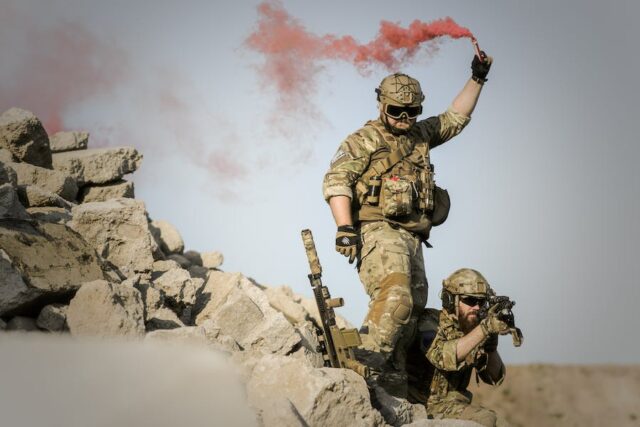America has the most powerful Army in the world, and this has gotten many people researching, “Who is the commander in chief of the Military?”
The military is a massive and complex organ of the government, and it needs clear and well-ordered management to keep it running.
The commander-in-chief is the topmost official in the military, and it might not be entirely clear who he is or his government role.
A deep dive into the government of the United States will make everything clear, so here is an overview of the matter;
Who Is Commander In Chief Of The Military?
The United States President is the Commander in Chief of all military branches. The Constitution states that the President shall be commander of all Armies and Navies.
This also includes the Air Force since by the time the Constitution was drafted, Congress hadn’t decided to make the Air Force a separate military branch. The President will use his power as supreme military leader to protect the United States and its people.
Understanding The Position Of Commander In Chief
A Commander in Chief is an individual who has supreme control and command over the military branch of a nation. It refers to the military managers within a country’s executive leadership, such as presidents and other government officials.
The term and position have existed for a long time, and many nations, even in medieval times, followed it through Kings. Kings would be in command of their armies and often went to war with the soldiers, but that has changed with time.
The official role of a ruler in charge of the armies is an idea adopted from the Romans. The Imperator was a ruler of the Roman Kingdom, Roman Empire, and Roman Republic, and he possessed imperium, which means he had military command and other regal powers.
The term was first used in the English Civil War where the head of State would be the military commander, whether a monarchy or a republic.
Sometimes, the power was held by another individual in the government, but the head of State maintained this right.
In most Parliamentary States, the executive branch of government depends on the legislative branch’s decisions. This means the military is tied to the legislature, but it doesn’t get its orders directly from it, so in a sense, the legislature doesn’t have command over the military.
A commander in Chief is sometimes called supreme commander to indicate that, ultimately, he is in charge of all the armies.
Sometimes, the term is used for subordinates to the head of State who have direct control over the military, even if it’s not a dictatorship.
The setup works, and many nations have adopted it over the years. In some countries, heads of State are actual military leaders and have the legal power to make decisions about Military actions and command the forces.
Most countries, however, have ceremonial powers for the head of State. This is mostly common in constitutional monarchs, parliamentary republics, and viceroys.
The heads of State, in this case, have small powers over the military, but significant decisions come down to the chief executives.
Some nations that use these structures include Albania, Australia, Denmark, Dominican Republic, Egypt, Ethiopia, Argentina, Bangladesh, Finland, France, Ghana, Belarus, South Korea, Belgium, Canada, Croatia, India, Ireland, Kenya, Italy, Malaysia, Mexico, Nigeria and many others.
The European Union and NATO use the Chief of Defense to refer to the highest-ranked professional military officer. It relates to people on active duty regardless of their powers or title.
The Role of Congress and The Commander In Chief Of The Military
The United States Constitution names the President as the “commander in chief of the Army and Navy of the United States.”
This phrase has changed meaning and even includes the Air Force, but the Constitution doesn’t say what the President does with this power.
The founding fathers believed that civilians should control the military since they are the ones who fund and join it. This is why they made the President, whom the people elect, the armed forces commander.
Military officers swear allegiance to the President and obey his laws, but the President doesn’t have power on the field or in strategy. These roles are reserved for people with more training and experience who understand how wars work.
The President exercises his power in other ways, with one of the common ones being ordering troops overseas to go to war.
He has to convene with his generals to talk it over, but he has the power to launch an attack against an overseas enemy if the Senate approves it.
An excellent example of a President using this power was when former President Bush sent the US Army to the Middle East in the early 2000s.
There can be many reasons for such deployments, including peacekeeping missions, the destruction of an enemy, or securing allies.
The President also uses his power as Commander in Chief to end hostilities that involve his Army by signing peace treaties and engaging in peace talks. The President doesn’t need Senate approval, and many leaders have gone out of their way to exercise this right.
In times of war, the President has the power to launch nuclear attacks against military or civilian targets that would weaken or defeat the enemy. An example of this was the bombings at Hiroshima and Nagasaki that ended the Second World War.
The President might be the commander in Chief, but Congress has a lot of control over the military. It plays essential roles in military command as follows;
1. Declaring war
According to the US Constitution, only Congress can declare war, not the President. In theory, the President can’t send the Army into a war unless Congress declares war against that nation, but this isn’t always the case.
Presidents have severally sent armies to war without Congress saying so, such as President Truman sending the military into Korea. Another example is Vietnam, where the American Army fought for over ten years without Congress’s authorization.
Some people suggest that the President should be able to go to war without Congress and that limiting him goes against the Constitution. Most presidents take this thought, and Congress rarely has a rebuttal.
2. Military Regulation
The Constitution also allows Congress to manage Military activities to prevent misuse of power or resources. Congress dictates how to deal with PoWs, gather information on enemies, or whether the military can target civilians.
President Bush’s administration tried to challenge this position in the aftermath of 9/11, but the Supreme Court disagreed with them. This critical law ensures the US military stays within acceptable ethical confines while waging war.
Many such laws are in place, including the one that gives the military the right to disobey an unlawful order. A soldier must refuse an illegal order that might harm Americans or needlessly cause harm to civilians in a country at war.
Overview of the United States Military
The United States Military is the most powerful in the world, and it owes most of this to the structure of its branches.
The military has evolved since its founding to adapt to the new world and stay on top of everyone else. Here are the branches that make up the United States Military;
The Army is the largest and oldest service in the United States Military. The Army provides forces that protect the US on land.
They use trucks, cars, humvees, tanks, and airplanes to achieve this task. The most important part, however, is the well-trained and equipped soldiers.
The Marine Corps is a part of the US Navy that produces specialized soldiers that form combat units for combat and contingency operations like the SEAL teams.
The Navy protects everything in the United States and allied waters. They have planes, carrier ships, and submarines that patrol the waters to protect them from pirates and enemies that would invade the sea.
The Air Force is one of the biggest reasons the US Army is so feared: it provides flexible, quick, and lethal air combat capabilities.
The Air Force has the most advanced jet fighters, RADAR systems, and military aircraft to give the Army and Navy an edge in warfare.
The Space Force protects US and allied military programs in space to ensure enemies don’t target satellites and other infrastructure crucial for military attacks.
The Coast Guard provides maritime safety and law enforcement for the environment and the people and sometimes offers military naval support.
The Coast Guard joins the Navy during times of war and during peace to protect from smugglers, pirates, and other naval threats.
The National Guard has an Army and Navy, which makes it a versatile branch that helps with many domestic emergencies and missions. They deal with humanitarian concerns and homeland security.
Conclusion
You now understand who is commander in Chief of the military and his roles in the government. Many countries have a commander-in-chief who is also the head of State, but it is ceremonial, and most don’t have real control over the military.
Even in cases of Presidents who control the Army, many safety measures manage how much power they have and how they can use it.
This ensures that all countries do their best to avoid war and wage war in an ethical manner that doesn’t harm innocent civilians.














